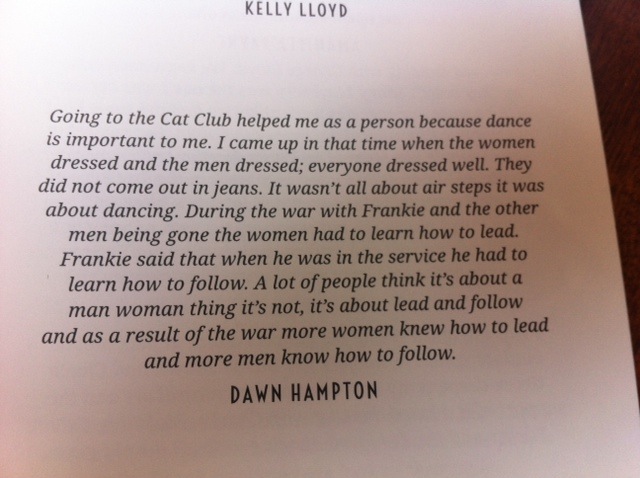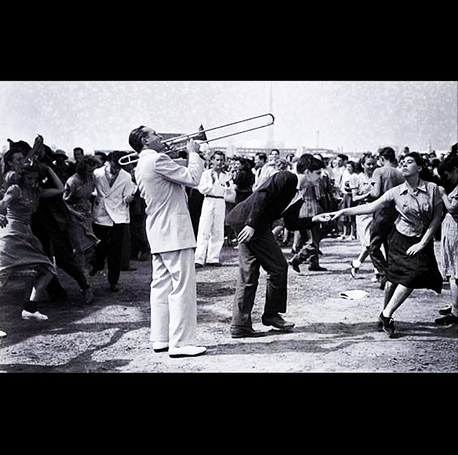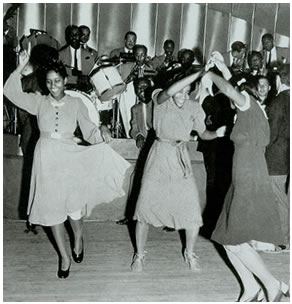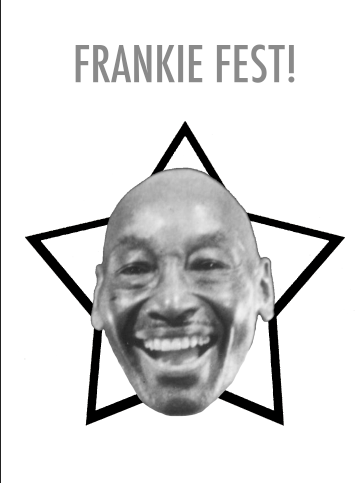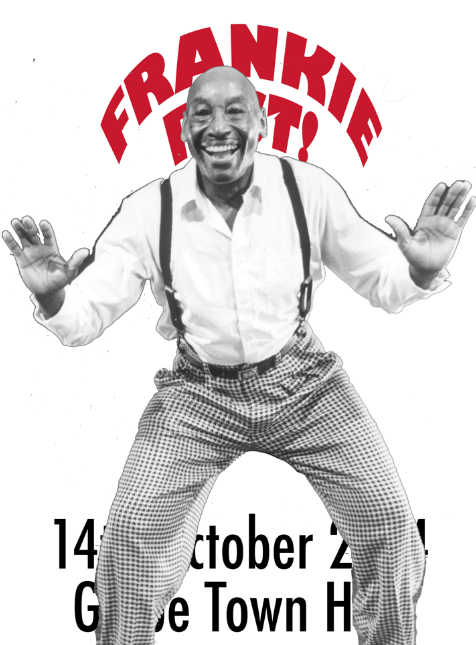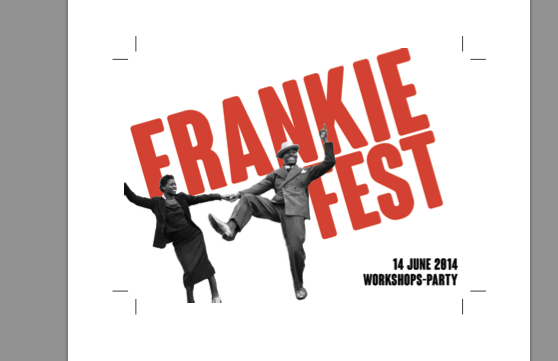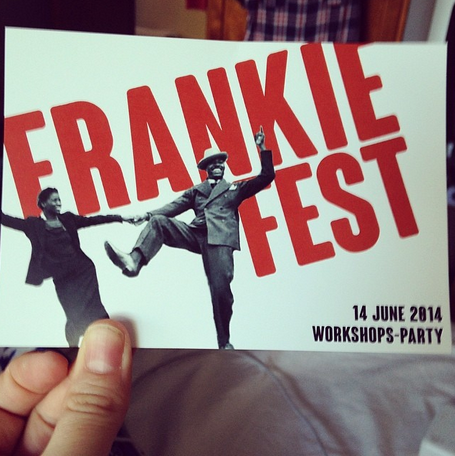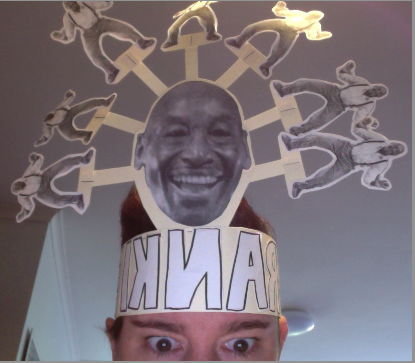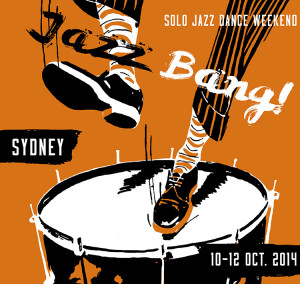Alright. This is totally out of context, and we needed to set up a broader class culture that supports this stuff before we tried it. But here are some teaching tools that we’ve been using over the past few months, and that I’ve found extra excitingly fun and effective.
I am just learning to teach. I’m always looking for new ways to do things. My goal is to pare back my teaching to the bare bones: less talking, fewer desperate metaphors and boring technical discussions. I love working with new teachers and new students because they bring new ideas and energy.
So this isn’t a finite list. It’s just a bunch of things I’m working on at the moment.
Just Join In.
Warm ups. I talked about them in the post Two Ways I Put Solo Dance Into My Lindy Hop Classes, so you can read about them there if you’re curious.
This sets up a culture or class vibe of self-motivated participation. Or, in human words, if you start doing something, the students watch a bit, and then join in when they feel ok about it.
SOLID GOLD.
They decide when they’re ok with it, it suggests that watching a bit first is ok, and you actually find students just jump in and try shit straight away.
But this can mean that they just jump in straight away, even when you need them to watch the first time.
So: Say ‘watch one time’ when you want them to watch, otherwise, just start the movement and do it until they just join in. You don’t even need to say “Join in when you’re ready” after a while – they just do it. But saying “Watch one time” is important for teaching them to observe as well.
Problem Solving.
This is a new one for me, and I don’t have the process down pat yet. My poor students are guinea pigs, but I think they actually quite like this, especially if I tell them that that’s what I’m doing – trying a new way of teaching.
Demonstrate a step. Then say “Figure out how this works.” Then let them figure it out in their own time. I only do this with intermediate or level 2 people – not with total beginners. Your job is to keep the partners rotating (but giving them enough time with each person to learn something, before letting them take those ideas to a new partner to share), to model the step clearly, to demonstrate as many times as they need, and to step in if they need a bit of clarification – don’t just let them flounder.
We only do this once per class, because it can be super frustrating.
I don’t have the process down for this yet, so it’s still a bit clunky.
Do hard stuff
Don’t baby your beginners: humans are amazingly competent. Teach them complicated rhythms, because they can do it. But you need to be able to break it down and teach it in a very simple way. So you need to know exactly what your body is doing at all times, and to be able to articulate that in very few words. I find that I need to learn a dance step, then be able to think my way through it, then watch myself to see if I’m actually doing what I say I’m doing, then I need to practice articulating it – and only take 10 seconds to explain it. It’s not enough to just learn a step myself. Learning a step myself is not the same as knowing how to teach it. Just like Frankie: charleston is just step step step, kick, step. That’s it.
Talk One Thing, Do That Thing.
After answering a student’s question, or offering one tip, we dance on it immediately. Only give one tip at a time.
If you wait, they forget. I usually answer a question, then say “Ok, let’s test it out” and we all dance on the issue to figure it out.
I try to respond to every question as though it was a really interesting, useful question. And they always are: a student asking a question tells you when you need to clarify things, and it’s a gauge of where their understanding is at. So it’s fabulous.
Don’t micromanage their learning.
Let them improve through repetition and doing; don’t correct every little thing, or explain in superdetail before they start dancing.
This is a hard one for me. I want to correct everything as we go. But lots of corrections tells students they’re doing it wrong, and makes them dependent on you. Letting them dance and dance and figure it out makes them self-reliant, encourages communication between partners, and makes for much better, natural movement and learning.
The corollary is: students learn over many classes, not all in one class. So take a long view approach to learning.
Don’t correct one student in front of the group.
Shane McCarthy gave me this tip. It’s gold. Don’t shame a student publicly like that. Tell them in the group, perhaps, but even then, you better make sure you REALLY need to tell them something. Because corrections can be upsetting for new students especially.
Ask students their opinions, and ask questions.
“New song?”
“Again without music, or to a song?”
“What’s next, after we do the swing out?”
“What are the leads going to work on now?” “And the follows?”
Only ask questions to reiterate what you’ve just said. Don’t ask open-ended questions that can have any sort of answer.
The only near-exception is “What’s the difference between these two things?” and demo two very different things – eg a rotating basic and a basic on the spot.
Sometimes if we’re doing a routine or a set sequence, I honestly can’t remember, so I ask them to remind me.
Do we panic if we make a mistake?
I usually ask this just before we do a bunch of dancing where they choose what moves they do in what order, or when we dance through a sequence. The answer is: “No!” and I usually reply “Because YOLO, right? We’re just dancing. Just pause, get your bounce on, jump in when you feel ready again.”
Other similar questions/comments: “If the swivels/variations are freaking you out, just drop them and do the vanilla version. Basics are beautiful.”
“What if you’re really lost?”
Sometimes we’re just not up to it. And I tend to say that “Some days it’s just not working. So be cool.” And I tell a story about this jazz class I did with Chester at Herrang on only a couple of hours sleep. My usual minimum is to be facing the right direction at the right time. But in this class, I could only manage bouncing in time. So minimum: bounce in time. Next level: face the right direction at the right time. Next level: claps – the best part.
I find that after I say this they usually actually work harder and don’t settle for doing this. It gives them confidence to make mistakes. I’m actually 100% serious: sometimes it’s all I can manage to just face the right direction at the right time.
“Pretend I don’t know the rhythm, and you’re teaching me. You have to demonstrate it really clearly so that I can figure it out and dance along.”
We do this is the solo classes when the rhythm looks a bit messy and vague. I find we get brilliant results immediately. This is a really useful tool for getting students to be confident, but you don’t actually mention confidence. We just get them to imagine that they’re the authority on the step. And they just ARE!
I might also say, “Ok, you need to convince me that this is the rhythm. And make it super clear.”
In our partner classes, I quite like to have them do this with a partner just after they’ve learn the rhythm on their own. I say “Ok, now you need to face your partner, and I want you to dance this rhythm like you’re showing them how to do it. You need to be really clear, so that they can see.” And that’s actually really powerful. It’s also a good way of introducing the idea that leads and follows mirror each other’s footwork.
Another way of doing this is to do a call-and-response exercise. I’ve seen Frida and Skye do this: in the circle in partners, one partner does a jazz step for a phrase, and the other has to join in and copy. Then you rotate, or the other partner has a turn, and the watching person gets to demonstrate. It’s super cool. And it makes you learn to watch and pay close attention to your partner. You can level it up by having the watching partner then dance the same step back to the first partner, but with a slight variation.
This exercise does what our exercise does, but you don’t explicitly say what the exercise is all about. I find that the best teaching eventually gets to the point where you never explain what you’re doing with an exercise, you just have them do it, and be in the exercise. So they’re practicing mindfulness – being present in the dancing. With beginners at least. Level 2 or 3 students are often interested in that ‘behind the scenes’ thinking, though.
Don’t shout, don’t speak when other people are speaking.
When the students rotate partners, they take the first moments to say hello to each other. They’re just about to touch each other, so they need to spend a few seconds reestablishing their ‘permissions’. Or learning each other’s names. So when they rotate, the noise level will go up. Don’t try to speak over this or to shush them: new dancers are here for this – for the social stuff. So let them do it. But don’t let it get out of control. We have a particularly rowdy couple of classes on Wednesday evenings, where we do need to remind them that we’re here to dance.
So I let the noise rise, crest, and then as it’s dropping, I step up. I might get their attention by just going straight into a demonstration of the next part (this where you NEED really strong, clear rhythm – so you can grab their attention just with your movements). Or I might say something.
I never say “Shoosh!” or “Be quiet!” or any of that stuff. I’m not a school teacher, and I’m not their parents; I’m not responsible for their behaviour, they are. I just assume that they are here to learn to dance, so I assume that they respect the fact that we need to be a bit organised. And I respect them, so I’m absolutely not going to tell them off or shriek at them.
Never shout at people. I might call the rhythm loudly, or I might count them in loudly, but I NEVER EVER EVER shout at students or anyone else. I might shout out with excitement: “Wahoo! Fantastic!” but I never shout at them to tell them off! No! That’s AWFUL!
I try not to interrupt my teaching partners, and if I do by accident, I apologise and say “I’m sorry, I interrupted, please do go on.” And I don’t tolerate it in class – it’s not ok to disrespect other students or the teachers by talking over them. It’s ok to have a bit of run-on conversation where you need to finish a comment or feedback with your partner, but if people continue to talk, I deal with it. I usually walk over and stand next to them. If they’re still talking (and everyone else is usually watching by this point), I put my hand on their shoulder, very gently. It’s usually immediately effective and they splutter into silence because I’ve surprised them. The most common culprits: older white men mansplaining following to a female partner. And you know how I feel about THAT.
I quite like a rowdy class, where people are talking and figuring stuff out together. But when we come together as a group, we should all listen to each other.
Do it as a group, then in your own time.
We often put together a specific sequence of steps, which we all dance together. This makes sense when you’re doing things like swing outs, where you start with the rhythm on the spot, then you rotate it, then you let go half way (swing out!), then you come together (circle into closed!), then you take out the middle bit and swing out open to open. If you teach it cumulatively, the order of steps is kind of important.
So we often have the students dance it all as a group together, in the sequence, once or twice. Without music first, because the quieterness is calming. Then we all realise we need the music to help us stop rushing the beat. So then we do it to music as a group. We rotate partners in between a few times.
Then we let them do the steps in their own time, and in their own order. This is the most important part: you learn to lead and follow here. It’s important to let them do this to music, and to spend AGES doing it. You can walk about and offer tips, but I find it’s better to not interrupt – to just let them figure it out. I might interrupt a couple if I see someone is freaking out, or if they’re being a bit uncareful with each other, or if we have a bossy boots partner in the class. But mostly, you just let them do it.
I haven’t figured out how to do this with solo properly yet. Though I do like the ‘take one minute on your own to figure out the step’ approach Ramona uses.
Be like Frankie
Frankie Manning would aim for a class full of happy, laughing students. Not perfect dancing. He was a harsh task master when it came to running a troupe, or if he was drilling you in a routine, but when it came to beginners, the goal was to have people happy and laughing.
Your goal, teaching anyone – from beginners to ninjas – is to make it easy for people to enjoy themselves. Yes, dancing is a discipline, and this can be super complicated stuff. But it is meant to bring us joy. It’s lindy hop. It can be a fierce, fiery joy, but it’s a joy.
When I teach, I want:
- LOLS. I want to laugh and have fun. And I want to laugh and have fun with my students. That’s why I’m there.
- Bodies moving. Adrenaline, endorphines, good times. Bodies in motion to music is pure joy. Doesn’t matter whether they ‘have it’, if they are laughing and moving their bodies, your class is a SUCCESS.
- Rhythm. The most important part of the step or dance is the rhythm. So you can ‘style’ it however you like: the rhythm comes first. In a technical sense, a clear rhythm is a consequence of clear weight transfer, good alignment, engaged cores, etc etc -> the bones of a good dance step.
- Swinging timing. Lindy hop is a swing dance, so it has to have a swung timing, not a straight timing. This is why I insist on bounce. I don’t want people to rush the beat, I want them back there behind the beat. I find humans are naturally inclined to speed up. So chilling out is super important.
- One jazz step per class. ONE JAZZ STEP is a minimum.
- Improvisation and innovation. I don’t want carbon copies. I want people to find their own way of doing a step, and to move in a way that is natural for their own bodies. I do NOT want a room full of people who dance like me. No! So I have to do the simplest, best dancing I can.
- Respect. We should all treat each other with respect. Each student is equally important, and the teachers aren’t any more important than the students. Everyone should feel this.
- Cherish your students. This is my own personal hardcore hippy goal with teaching: these people are important. So cherish them. Each person has something new to bring to the dance; be alert to that, welcome it, seek it out. I find that this helps me get over myself if I’m worrying that I’m not doing a good teaching job. If I open myself up to the ideas that they bring to class, I stop worrying and really enjoy myself.
- LOLS. LOLS. LOLS. We should be having fun. I cannot say this enough. Everyone – teachers, students, onlookers – should be enjoying this time with music and dancing with other people.
I think of teaching as collaboration between people. Lindy hop is about working with other people.
To me, this is why lindy hop can be a feminist project: it’s about respect for each other, and valuing other people’s contributions to a big conversation or project.
There’s a moment when we listen to a song in class, and I say “There are 15 men all finding one beat and taking care of it together. Let’s get with them.” And then we all dance and bounce in time and I say “Now there are THIRTY (or forty or whatevs) people taking care of the beat!” and I think that that is what lindy hop is. We are all working together to keep a shared time, to take care of a beat. All listening to each other, and working in accord, yet still all able to improvise and contribute in a unique way. That’s what teaching jazz dance is to me.

